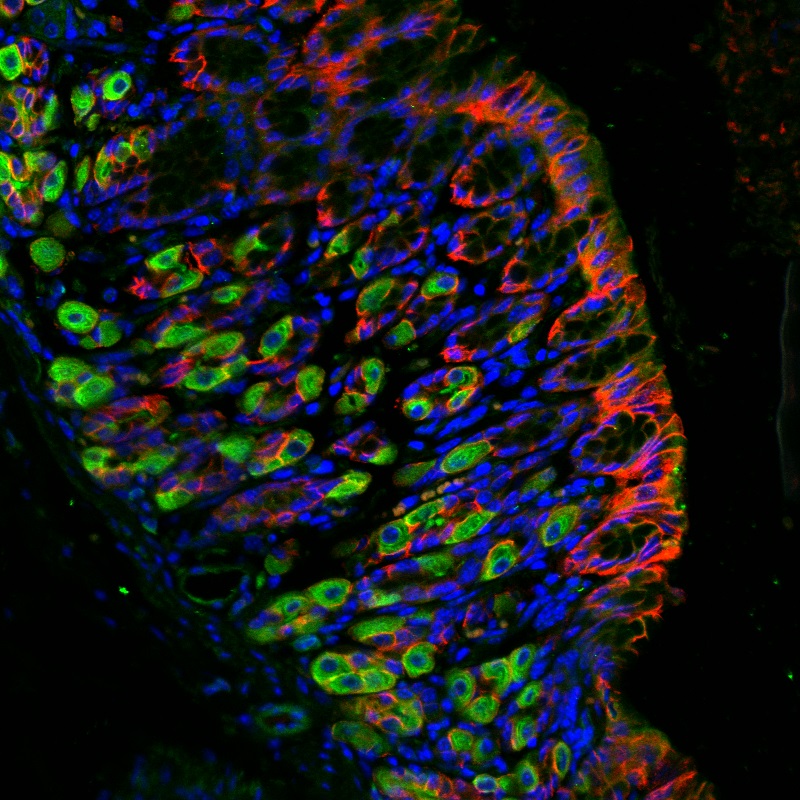
Singapore team's discovery of new genomic aberrations of gastric cancer could pave the way for precision medicine

Immunofluorescence image of human stomach section stained for ARHGAP26 (green), epithelial cadherin (red) and cell nuclei (blue). Epithelial cadherin is present in all epithelial cell types of the stomach, whereas ARHGAP26 is restricted to parietal cells. Since CLDN18 has a similar expression pattern as epithelial cadherin, the fusion of ARHGAP26 to CLDN18 will result in the expression of ARHGAP16 activity in all epithelial cells.
Copyright : A*STAR
Singapore scientists from A*STAR’s Genome Institute of Singapore (GIS) and Institute of Molecular and Cell Biology (IMCB), together with colleagues from the National University Health System (NUHS) and Tan Tock Seng Hospital, have discovered a relationship between Asian gastric cancers and the fusion of two genes.
The researchers discovered that the fusion of these two genes, known as CLDN18 and ARHGAP26, gives rise to the destruction of the stomach surface barrier, resulting in gastric acids affecting the stomach tissues. Moreover, CLDN18-ARHGAP26 also hampers wound-healing.
Findings from the study were published in the scientific journal Cell Reports.
Structural changes of chromosomes (genome rearrangements), can result in gene fusions with properties that can cause cancer. The three-dimensional organisation of the genome, known as the chromatin structure, plays a role for the generation of rearrangements. Using a technique known as DNA paired-end-tag (DNA-PET) whole genome sequencing, GIS scientists analysed 15 gastric cancers (GCs) from Southeast Asians, and observed that rearrangements were enriched in regions of active genes. They subsequently screened 100 GCs for certain fusion genes that were discovered in the 15 GCs.
Through the sequencing, the scientists identified seven hotspots across the genome which had many rearrangements as well as 136 gene fusions. In three out of the 100 GC cases, they found recurrent fusions between CLDN18, a tight junction gene, and ARHGAP26, a gene encoding an RHOA inhibitor. The functions of both genes are important for a tight inner surface (epithelium) of the stomach. Epithelial cell lines expressing the fused genes CLDN18-ARHGAP26 displayed a dramatic loss of epithelial phenotype and long protrusions indicative of epithelial-mesenchymal transition (EMT)[1]. Fusion positive cell lines showed impaired barrier properties, reduced cell-cell and cell-extracellular matrix-adhesion, retarded wound healing and inhibition of RHOA. Gain of invasion, a property that contributes to metastases, was seen in cancer cell lines expressing the fusion.
Dr Axel Hillmer, Group Leader of GIS and senior author of the publication said, “We identified five different fusion genes recurrently in several tumours, one of these fusion genes is CLDN18-ARHGAP26. Our simulations indicate that the recurrence is unlikely to be by chance, suggesting that the other four fusion genes might also play a role in the development of gastric cancer.”
Overall, CLDN18-ARHGAP26 mediates epithelial disintegration possibly leading to leakage of gastric acids, and the fusion might contribute to invasiveness of tumours once a cell is transformed.
Dr Walter Hunziker, Deputy Director of IMCB and co-senior author of the publication, added, “CLDN18 is a critical component of the gastric epithelial barrier. Fusion of ARHGAP26 to CLDN18 not only interferes with the tethering of CLDN18 to the actin cytoskeleton, but could also affect the actin cytoskeleton by inhibiting RHOA at the wrong location, thereby compromising barrier integrity. The resulting inflammation and gastritis are well known risk factors for gastric cancer.”
“Gastric cancer has a high incidence in Asia, and it is important for Asian scientists to improve our understanding of diseases which are important in our population. This joint study combines the efforts of scientists and clinicians in multiple institutions in Singapore, including GIS, IMCB, TTSH and NUHS,” said Deputy Chief Executive (Academic Enterprise) at NUHS, Assoc Prof Yeoh Khay Guan. “The present new finding describes a fusion gene which causes a breakdown of the protective gastric lining and which could help the cancer to spread. This is one more important step in advancing our understanding of gastric cancer which will ultimately lead to better treatment for this disease.”
Prof Ng Huck Hui, Executive Director at GIS said, “Gastric cancer is the 5th most common cancer worldwide, with the highest incidence in Asia. This is another excellent example of how important collaborations between research institutes, academia and hospitals can result in spectacular discoveries, to advance possible cures for the disease.”
The study, made possible through collaboration between GIS, IMCB, NUHS and Tan Tock Seng Hospital and support by A*STAR, showcased the importance of such collaborative efforts between researchers and clinicians. The Translational and Clinical Research Flagship Programme – The Singapore Gastric Cancer Consortium[2] – is supported by the Singapore National Research Foundation and administered by the Singapore Ministry of Health’s National Medical Research Council.
References:
[1] EMT is a process by which epithelial cells lose their cell polarity and cell-cell adhesion, and gain migratory and invasive properties to become mesenchymal stem cells (multipotent stromal cells that can differentiate into a variety of cell types). EMT is essential for numerous developmental processes including mesoderm formation. EMT has been shown to occur in wound healing, in organ fibrosis and in the initiation of metastasis for cancer progression. (http://en.wikipedia.org/wiki/Epithelial%E2%80%93mesenchymal_transition)
[2] http://www.nmrc.gov.sg/content/nmrc_internet/home/grant/compgrants/tcrcancer.html
Associated links
A*STAR article












